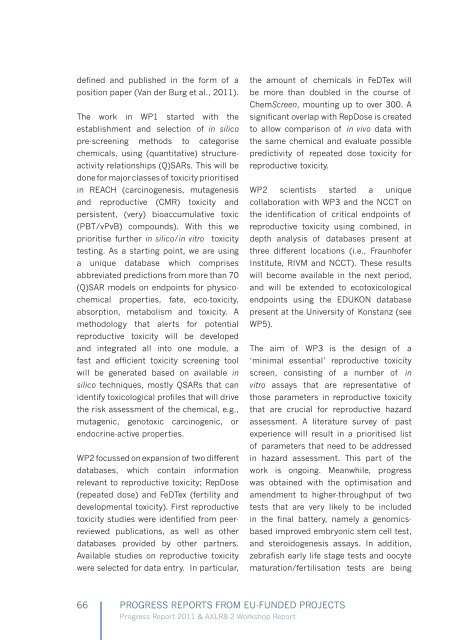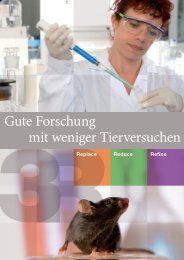Create successful ePaper yourself
Turn your PDF publications into a flip-book with our unique Google optimized e-Paper software.
defined and published in the form of a<br />
position paper (Van der Burg et al., 2011).<br />
The work in WP1 started with the<br />
establishment and selection of in silico<br />
pre-screening methods to categorise<br />
chemicals, using (quantitative) structureactivity<br />
relationships (Q)SARs. This will be<br />
done for major classes of toxicity prioritised<br />
in REACH (carcinogenesis, mutagenesis<br />
and reproductive (CMR) toxicity and<br />
persistent, (very) bioaccumulative toxic<br />
(PBT/vPvB) compounds). With this we<br />
prioritise further in silico/in vitro toxicity<br />
testing. As a starting point, we are using<br />
a unique database which comprises<br />
abbreviated predictions from more than 70<br />
(Q)SAR models on endpoints for physicochemical<br />
properties, fate, eco-toxicity,<br />
absorption, metabolism and toxicity. A<br />
methodology that alerts for potential<br />
reproductive toxicity will be developed<br />
and integrated all into one module, a<br />
fast and efficient toxicity screening tool<br />
will be generated based on available in<br />
silico techniques, mostly QSARs that can<br />
identify toxicological profiles that will drive<br />
the risk assessment of the chemical, e.g.,<br />
mutagenic, genotoxic carcinogenic, or<br />
endocrine-active properties.<br />
WP2 focussed on expansion of two different<br />
databases, which contain information<br />
relevant to reproductive toxicity; RepDose<br />
(repeated dose) and FeDTex (fertility and<br />
developmental toxicity). First reproductive<br />
toxicity studies were identified from peerreviewed<br />
publications, as well as other<br />
databases provided by other partners.<br />
Available studies on reproductive toxicity<br />
were selected for data entry. In particular,<br />
the amount of chemicals in FeDTex will<br />
be more than doubled in the course of<br />
ChemScreen, mounting up to over 300. A<br />
significant overlap with RepDose is created<br />
to allow comparison of in vivo data with<br />
the same chemical and evaluate possible<br />
predictivity of repeated dose toxicity for<br />
reproductive toxicity.<br />
WP2 scientists started a unique<br />
collaboration with WP3 and the NCCT on<br />
the identification of critical endpoints of<br />
reproductive toxicity using combined, in<br />
depth analysis of databases present at<br />
three different locations (i.e., Fraunhofer<br />
Institute, RIVM and NCCT). These results<br />
will become available in the next period,<br />
and will be extended to ecotoxicological<br />
endpoints using the EDUKON database<br />
present at the University of Konstanz (see<br />
WP5).<br />
The aim of WP3 is the design of a<br />
‘minimal essential’ reproductive toxicity<br />
screen, consisting of a number of in<br />
vitro assays that are representative of<br />
those parameters in reproductive toxicity<br />
that are crucial for reproductive hazard<br />
assessment. A literature survey of past<br />
experience will result in a prioritised list<br />
of parameters that need to be addressed<br />
in hazard assessment. This part of the<br />
work is ongoing. Meanwhile, progress<br />
was obtained with the optimisation and<br />
amendment to higher-throughput of two<br />
tests that are very likely to be included<br />
in the final battery, namely a genomicsbased<br />
improved embryonic stem cell test,<br />
and steroidogenesis assays. In addition,<br />
zebrafish early life stage tests and oocyte<br />
maturation/fertilisation tests are being<br />
66 PROGRESS REPORTS FROM EU-FUNDED PROJECTS<br />
Progress Report 2011 & AXLR8-2 Workshop Report




